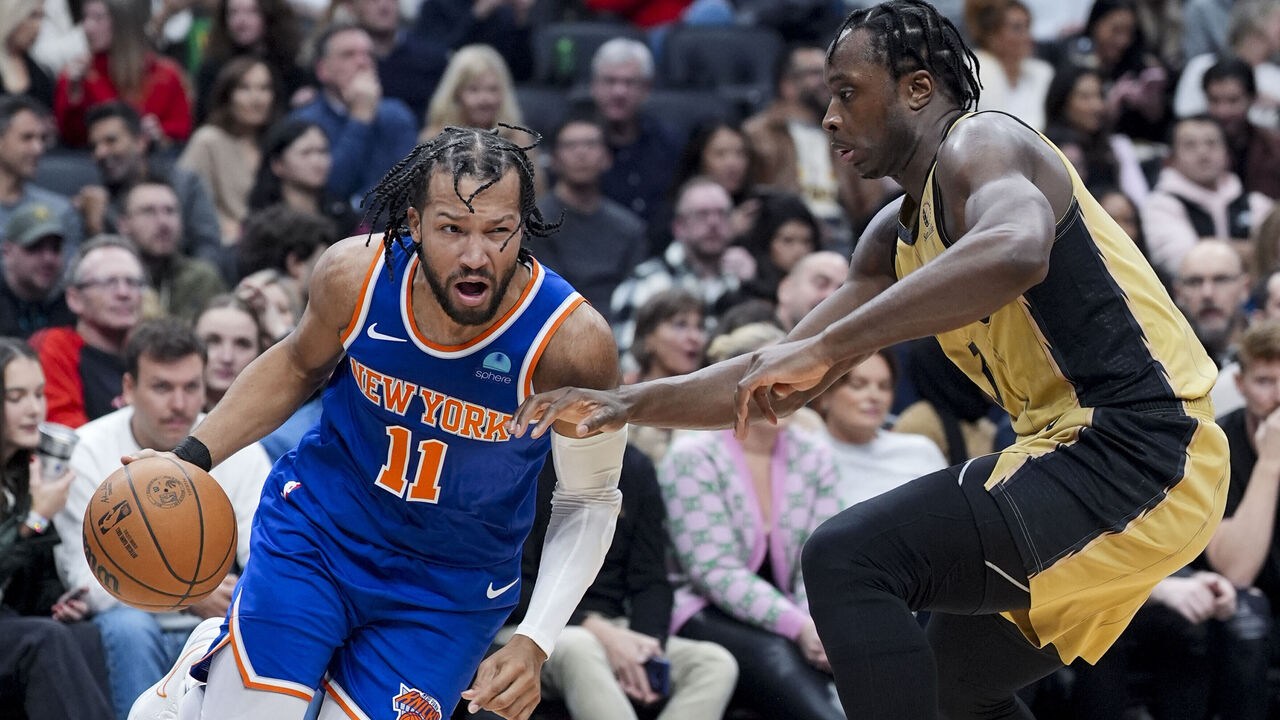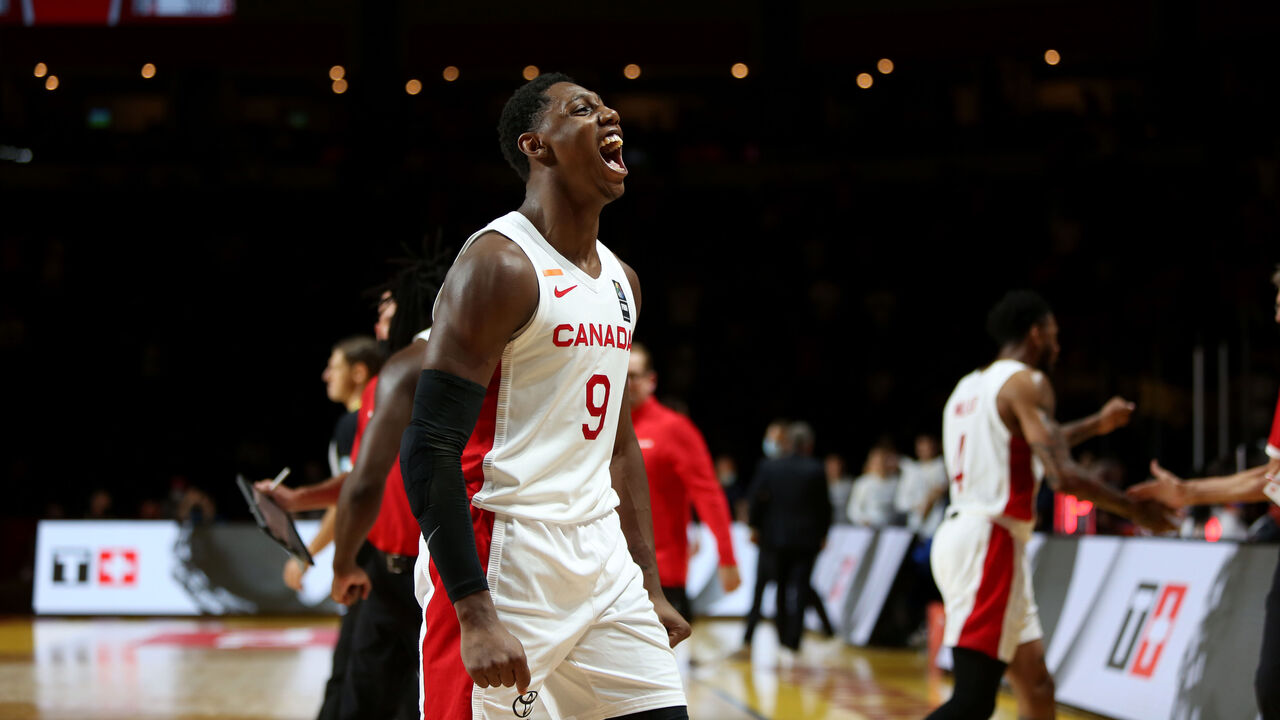O.G., Oh My: Breaking down the Raptors-Knicks deal
After being paralyzed by indecision for the better part of two seasons, the Toronto Raptors finally began overhauling their roster, trading O.G. Anunoby to New York in a holiday-season stunner. Here’s why the deal could prove to be a win-win for two teams that also happen to be embroiled in a legal battle.
To New York: O.G. Anunoby, Precious Achiuwa, Malachi Flynn
To Toronto: Immanuel Quickley, RJ Barrett, 2024 2nd-round pick (via DET)
Knicks on fringes of contention

For a Knicks team closer to contention than the Raptors, Anunoby is a perfect fit. The 26-year-old forward is a star in his role as an all-world defender and spot-up shooter, a connective piece who fits seamlessly within any roster construct.
That the Knicks acquired Anunoby while getting off Barrett’s contract and breaking up the Barrett-Julius Randle pairing is icing on the cake. New York was never sniffing a championship while paying Barrett and Randle, two high-volume, non-shooters with limited playmaking vision.
| NYK net rating | 2022-23 | 2023-24 |
|---|---|---|
| Randle + Barrett on | -2.3 | -1.7 |
| Randle on/RJ off | +11.9 | +5.8 |
| RJ on/Randle off | +1.5 | +1.1 |
Randle clearly established himself as something closer to a secondary star than Barrett. And Anunoby should complement Randle and star guard Jalen Brunson better than Barrett did (on both ends of the court).
However, losing Quickley hurts on several fronts. The up-tempo guard gave the plodding Knicks a different gear off the bench. Replacing Quickley and Barrett with Anunoby also leaves the Knicks with a lot less self-creation than the team boasted just days ago, which could come back to bite them in the playoffs.
The Knicks are still another impact player away from legitimate contention, and they just moved their best trade chip in Quickley (New York’s trove of extra first-round draft picks are all heavily protected). Anything approaching max cap space is also off the table this summer if New York re-signs Anunoby, who could command a max contract that starts at around $42.6 million per year.
Whether it’s at the max or slightly less, Anunoby staying in New York seems like a pretty safe bet and one the Knicks would’ve been confident in while completing this trade. Anunoby is a client of the agency Knicks president Leon Rose once worked for (CAA), Rose’s son is Anunoby’s agent, and the Knicks have stockpiled CAA clients on the court and the sidelines (even Tom Thibodeau is a CAA coach).
All that aside, Anunoby is a sensible upgrade for where this team is trying to go.
Taking a flier on Achiuwa and Flynn may ultimately prove meaningless, but in the case of Achiuwa, at least, there’s still untapped potential worth exploring. The dynamic big man is a versatile, switchable defender who has shown flashes of rim protection and 3-point range. Unfortunately, those flashes have come fewer and further between over the last couple of seasons after a 2021-22 breakout.
On the one hand, it’s plausible defensive guru Thibodeau can help Achiuwa rediscover some of that potential, especially given the Knicks could use some frontcourt help after losing Mitchell Robinson to injury. On the other hand, it’s equally possible New York’s no-nonsense head coach quickly tires of Achiuwa’s poor decision-making.
Flynn has rarely looked like an NBA-caliber guard through four seasons. There might be a 3-and-D reserve in there somewhere, and perhaps the Knicks believe Thibodeau can coax it out of him.
Raptors find their guard of the future

Saturday’s loss in Detroit, which handed the Pistons their first win in over two months, was a fitting rock-bottom for a Raptors team that had grown woefully stale. Toronto desperately needs a breath of fresh air and to begin planning for a Scottie Barnes-led future.
Enter Quickley (and, to a lesser extent, Barrett).
As a quick guard who can create for himself, serve as a pull-up threat, and shoot from deep, Quickley is a perfect fit beside Barnes.
| % of FG’s that were unassisted | Quickley | Anunoby |
|---|---|---|
| 2023-24 2P | 60.2% | 27.1% |
| Career 2P | 72% | 42.8% |
| 2023-24 3P | 28.1% | 4.9% |
| Career 3P | 36.1% | 6.0% |
Over the last two seasons, Quickley has averaged 15 points in less than 28 minutes per game while shooting 51.8% inside the arc, 37.7% from deep (on 5.5 attempts per contest), and 83.3% from the free-throw line. Among 63 players who’ve attempted at least four pull-up shots per game this campaign, Quickley’s effective field-goal percentage of 53.5% ranks eighth, according to NBA.com, sandwiching him between Trae Young (53.7%) and Tyler Herro (53.5%). That figure is bolstered by the fact that Quickley is shooting better than 40% on pull-up threes.
A 40.4% shooter on catch-and-shoot 3-pointers, Quickley’s speed also allows him to attack closeouts and get to his floater range, where he’s a 75th-percentile finisher among combo guards, according to Cleaning The Glass.
While not a pure point guard, Quickley’s a fine secondary playmaker who takes care of the ball and should thrive playing with a point forward like Barnes. He’s also a great on-ball defender at the point of attack.
With no star guard in front of him, the 24-year-old should finally be able to spread his wings as a full-time starter.
In turning Anunoby into a young guard who can thrive alongside Barnes for years to come, the Raptors also traded an unrestricted free agent for one of the restricted variety, with Toronto owning the right to match any rival offers for Quickley this summer. The team’s front office faced fair criticism for its handling of last year’s trade deadline, losing Fred VanVleet for nothing in free agency, and for how the Pascal Siakam situation has played out. But if the Raptors believed Anunoby was a flight risk or that he’d struggle to play up to the value of his next contract, flipping him for a perfectly fitting youngster like Quickley was an excellent piece of asset management.
In the short term, the acquisition should move Dennis Schroder to a bench role he’s better suited to and give Toronto two capable guards for what feels like the first time in forever (three years).

Contrary to popular (Canadian) belief, Barrett’s role in this deal was that of mere salary filler until the Canadian forward proves otherwise. Given his age and the scoring skills Barrett possesses in a 6-foot-6, 214-pound frame, the 23-year-old still has All-Star upside. But the reality is that he’s been a mostly frustrating and inconsistent player through five seasons.
Among 48 players who’ve attempted at least 15 shots per game over the last four campaigns, Barrett’s effective field-goal percentage (48.2) ranks 45th. Aside from shooting 40% from deep during his sophomore season, Barrett has scored at below-average efficiency from every area of the court (rim, floater range, long mid-range, corner threes, non-corner threes) in every campaign of his career, according to Cleaning The Glass. Meanwhile, his playmaking and defense stagnated or regressed.
The tools and size are there, but the results have thus far suggested Barrett’s not cut out for a primary or even secondary role. And to fit in as something less than that on a good team – think the role Andrew Wiggins found in Golden State – Barrett would have to suddenly become a good 3-point shooter, as Wiggins miraculously did in his seventh season.
It’s not impossible, and perhaps a Canadian homecoming is just what Barrett needs to finally put it all together, but Quickley is unquestionably the centerpiece of this trade for Toronto. If Barrett can play himself into a role as part of the Raptors’ Barnes-led future, or even to a point where he can be flipped for surplus value, this trade goes from good to a home run for the Raps.
One thing Barrett does provide is an upgrade in self-creation compared to Anunoby. Though the efficiency isn’t there yet, perhaps having another player capable of competently putting the ball on the floor and beating opponents off the dribble will help juice the Raptors’ offense.
Though a second-round pick rarely raises eyebrows, it’s worth noting that the selection Toronto acquired is via the league-worst Pistons. It’s quite likely the pick turns into the 31st selection in this year’s draft, an advantageous section of the second round where teams essentially get late-first-round value without needing to pay first-round, rookie-scale money. In addition, as part of the league’s new collective bargaining agreement, teams can now sign second-round picks to three- and four-year contracts without using their cap space or dipping into their mid-level exception.
It’ll be fascinating to see whether this move changes the Raptors’ plans for Siakam. Was Anunoby just the first domino to fall as part of a long-overdue firesale, or does a more sensibly built core – with Quickley replacing Anunoby – mean Siakam and Barnes can better coexist? With the logjam at forward somewhat remedied and one unrestricted free agent now out of the picture, Toronto might not feel the same pressure to move Siakam.
If they’re not blown away by an offer and believe they can re-sign the two-time All-Star to a contract they’re comfortable with, perhaps the Raptors retain Siakam and consider moving him later. However, Toronto would be wise to rip the Band-Aid off if a deal presents itself with the same upside as this one.
For now, another remnant of the Raptors’ championship core is gone. At least this time, it’s not for nothing. Far from it.
Joseph Casciaro is theScore’s senior content producer.


